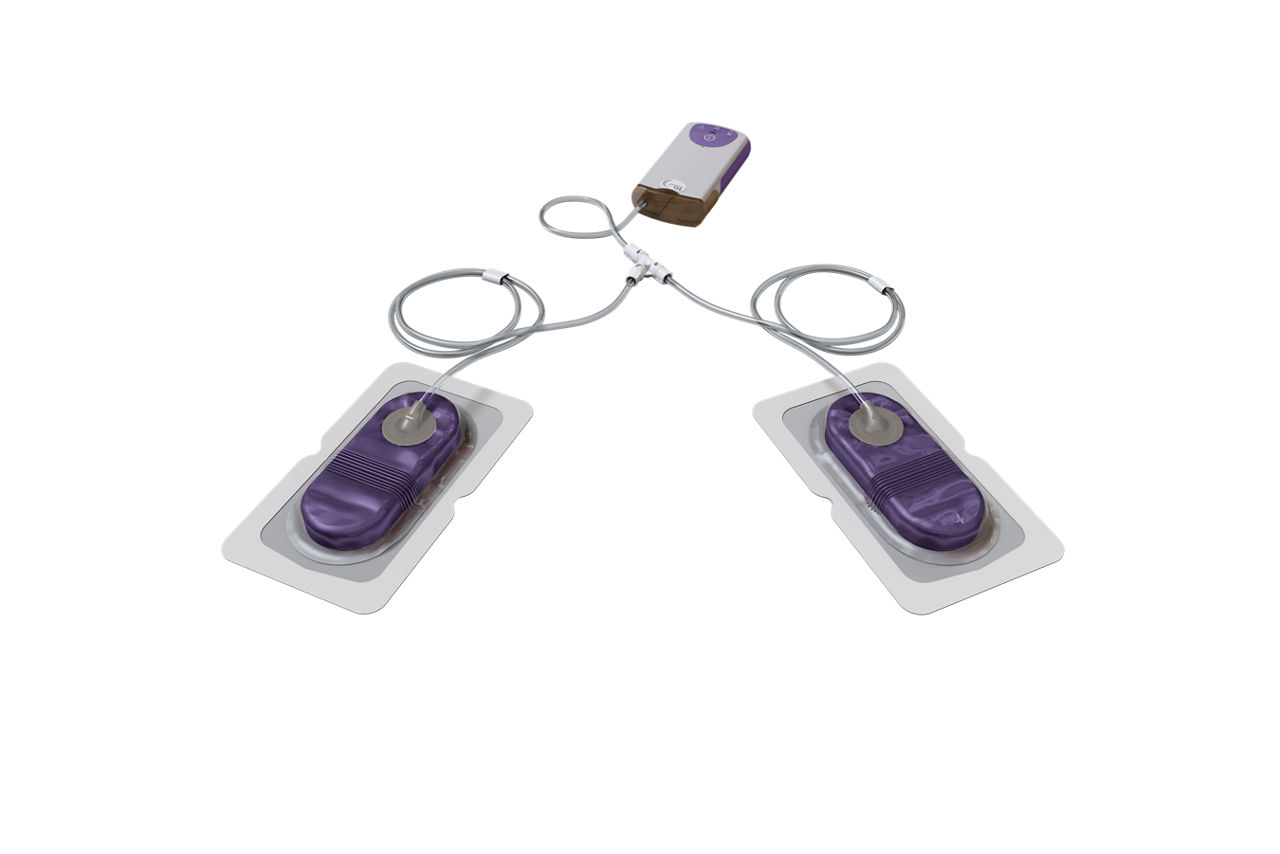Sistema de tratamiento para incisiones 3M™ Prevena™ Duo
Acerca del producto
El Kit del Sistema PREVENA DUO™ es un sistema descartable de terapia por presión negativa, siendo compuesto de una unidad de terapia fácil de usar y dos vendajes integrados en una pieza. El Kit del Sistema PREVENA DUO™ fue desarrollado para ser usado en dos incisiones lineales de hasta 13 cm de longitud – son dos incisiones y una sola solución.
Detalles del producto
El Sistema PREVENA™ incorpora todos los elementos funcionales de la terapia por presión negativa necesarios para la gestión de distintos tipos de incisiones quirúrgicas cerradas. El portafolio 3M™ de vendajes portátiles y flexibles y unidades de terapia provee beneficios como facilidad de uso y flexibilidad para gestionar y proteger las incisiones quirúrgicas después del cierre primario. El Sistema PREVENA™ ayuda a mantener juntos los bordes de la incisión, reduce el edema y remueve fluidos y material infeccioso en un recipiente reemplazable. Él actúa como una barrera a la contaminación externa y provee presión negativa continua de 125 mmHg por hasta 7 días en el lugar de la incisión.
Las Unidades de Terapia PREVENA™ 125 y PREVENA PLUS™ 125 gestionan el ambiente de incisiones quirúrgicas cerradas y remueven el fluido por medio de la aplicación de presión negativa continua de 125 mmHg. Más de 70 estudios clínicos publicados, relativos a una variedad de incisiones quirúrgicas y poblaciones de pacientes, demuestran que el Sistema de Gestión de Incisiones PREVENA™ está asociado a resultados clínicos positivos en comparación con vendajes postoperatorios estándar.
- El Kit del Sistema PREVENA DUO™ está proyectado para uso en dos incisiones lineales de hasta 13 cm de longitud
- La Unidad de Terapia PREVENA™ 125 provee presión negativa continua y predefinida de 125 mmHg
- La Unidad de Terapia PREVENA™ 125 es un dispositivo descartable para uso en un único paciente con 3 pilas AA preinstaladas (Peso: 0,2 kg; Dimensiones: 13,6 x 7,5 x 3 cm)
- Recipiente reemplazable de 45 mL (de uso único, estéril y descartable)
- Alertas visuales/sonoras para seguridad del paciente
- Dos Vendajes PREVENA™ (espuma de poliuretano) canalizan la presión negativa para el área de la incisión e incluyen la capa de interfaz con la piel que absorbe activamente el fluido de la incisión
- La Capa de Interfaz con la Piel del Vendaje PREVENA™ contiene un 0,019% de plata iónica, lo que reduce la colonización bacteriana en el tejido
- El paciente puede bañarse incluso usando el(los) Vendaje(s) PREVENA™
Aplicaciones sugeridas
- Gestión de incisiones postoperatorias
- Cirugías ortopédicas, vasculares, generales y plásticas reconstructivas
Legal
¹ Outside US (OUS) Prevena Therapy instructions for use / OUS indication statement ² Wilkes RP, Kilpad DV, Zhao Y, Kazala R, McNulty A. Closed Incision management with negative pressure wound therapy (CIM): biomechanics. Surg Innov. 2012;19(1):67–75. doi:10.1177/1553350611414920. Glaser DA, Farnsworth CL, Varley ES, et al. Negative pressure therapy for closed spine incisions: a pilot study. Wounds. 2012;24(11):308–316. ⁴ Kilpadi DV, Cunningham MR. Evaluation of closed incision management with negative pressure wound therapy (CIM): hematoma/seroma and involvement of the lymphatic system. Wound Repair Regen. 2011;19(5):588–596. doi:10.1111/j.1524-475X.2011.00714.x. 5. Ferrando PM, Ala A, Bussone R, Bergamasco L, Actis Perinetti F, Malan F. Closed incision negative pressure therapy in oncological breast surgery: comparison with standard care dressings. Plast Reconstr Surg Glob Open. 2018 Jun 15;6(6):e1732. doi:10.1097/GOX000000000000173 3. Pleger SP, Nink N, Elzien M, Kunold A, Koshty A, Boning A. Reduction of groin wound complications in vascular surgery patients using closed incision negative pressure therapy (ciNPT): a prospective, randomised, single-institution study. Int Wound J. 2018;15(1):75-83. 4. Cooper HJ, Bas MA. Closed-incision negative-pressure therapy versus antimicrobial dressings after revision hip and knee surgery: a comparative study. J Arthroplasty. 2016 May;31(5):1047-1052. doi:10.1016/j.arth.2015.11.010 5. Redfern RE, Cameron-Ruetz C, O’Drobinak SK, Chen JT, Beer KJ. Closed incision negative pressure therapy effects on postoperative infection and surgical site complication after total hip and knee arthroplasty. J Arthroplasty. 2017;32:3333-3339. doi:10.1016/j.arth.2017.06.019 6. Newman JM, Siqueira MBP, Klika AK, Molloy RM, Barsoum WK, Higuera CA. Use of closed incisional negative pressure wound therapy after revision total hip and knee arthroplasty in patients at high risk for infection: a prospective, randomized clinical trial. J Arthroplasty. 2019 Mar;34(3):554-559e1. doi:10.1016/j.arth.2018 7. Stannard JP, Volgas DA, McGwin G 3rd, et al. Incisional negative pressure wound therapy after high-risk lower extremity fractures. J Orthop Trauma. 2012;26(1):37‐42. doi:10.1097/BOT.0b013e318216b1e5. 8. Grauhan O, Navasardyan A, Hofmann M, et al. Prevention of poststernotomy wound infections in obese patients by negative pressure wound therapy. J Thorac Cardiovasc Surg. 2013;145:1387-1392. 9. Gabriel A, Sigalove S, Sigalove N, et al. The impact of closed incision negative pressure therapy on postoperative breast reconstruction outcomes. Plast Reconstr Surg Glob Open. 2018 Aug; 6(8): e1880.doi:10.1097/GOX.0000000000001880 10. Stannard JP, Volgas DA, McGwin G 3rd, et al. Incisional negative pressure wound therapy after high-risk lower extremity fractures. J Orthop Trauma. 2012;26(1):37‐42. doi:10.1097/BOT.0b013e318216b1e5. 11. Kwon J, Staley C, McCullough M, Goss S, Arosemena M, Abai B, Salvatore D, Reiter D, DiMuzio P. A randomized clinical trial evaluating negative pressure therapy to decrease vascular groin incision complications. J Vasc Surg. 2018 Dec;68(6):1744-1752. doi: 10.1016/j.jvs.2018.05.224. Epub 2018 Aug 17. PMID: 30126781. 12. Gabriel A, Maxwell GP. Economic Analysis Based on the Use of Closed-Incision Negative-Pressure Therapy after Postoperative Breast Reconstruction. Plast Reconstr Surg. 2019 Jan;143(1S Management of Surgical Incisions Utilizing Closed-Incision Negative-Pressure Therapy):36S-40S. doi: 10.1097/PRS.0000000000005311. PMID: 30586102. 13. Gabriel A, et al, Effects of Negative-Pressure Wound Therapy with Instillation versus Standard of Care in Multiple Wound Types: Systematic Literature Review and Meta-Analysis, Plastic & Reconstructive Surgery, 2021 Jan 1;147(1S-1):68S-76S. 14. Gabriel A, Kahn K, Karmy-Jones R. Use of negative pressure wound therapy with automated, volumetric instillation for the treatment of extremity and trunk wounds: clinical outcomes and potential cost-effectiveness. Eplasty. 2014; 14: e41.Especificaciones del producto
| Nombre de la categoría |
Nombre de la categoría
Juegos NPT |
| Longitud Total (Imperial) |
Longitud Total (Imperial)
5.12 in |
| Longitud total |
Longitud total
13 cm |
| Marca |
Marca
Prevena™ |

